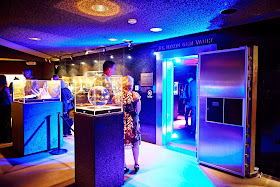The Blue Moon Diamond, which we have been covering in the past few articles here and here finally has made it to our museum, welcomed by one of the largest museum events of the year. Both beautiful and scientifically significant, it has generated much buzz in both the general public and scientific community.
The day opened to great pizazz with a press conference at 9:30 AM, complete with a catered breakfast.
When the black cloth was pulled off, the diamond was presented to the press for the very first time.
Dr. Eloïse Gaillou and Suzette Gomes of Cora International answered questions about the history, production, and rareness of the Blue Moon diamond.
As readers of this blog will know, the diamond was mined in the Cullinan Mines of South Africa, a mine that has produced other famous diamonds such The Star of Africa and the Golden Jubilee. To learn more about those diamonds, click here. Knowing the source of the diamond is just as important as the chemical make up of the diamond itself.
Suzette presented the resin duplicates of the original 29.6 carat raw diamond, explaining the meticulous process of creating the rough to the polished final.
 |
| Edgar Chamorro © for NHMLA |
The Blue Diamond's final size which stands at an impressive 12 carats, is especially notable for its flawlessness and color, which are much rarer at gems of this size.
Eloïse finished off the press conference with an interview by Channel 7.
There was no rest for the weary after the press event, however, because the official welcoming party would be taking place in a few hours. We had to set up and prepare and make sure everything ran smoothly. There was furniture to be arranged, flowers to place, lights to change, and general chaos that comes about when running events such as these.
The flowers were designed by Mille Fiori and were the centerpieces of each table.
 |
| Tiffany Arnolds © for NHMLA |
 |
| Mario DeLopez © for NHMLA |
 |
| Mario DeLopez © for NHMLA |
Setting up everything while not trying to run each other over was bit difficult.
 | ||
Mario DeLopez © for NHMLA
|
 |
| Mario DeLopez © for NHMLA |
The official party started at 7, and guests at the party entered from the north entrance, where they were checked in by these lovely ladies, the work study students and interns of the Gem and Mineral department.
Directly in front of the table were two photos of the eponymous diamond. One was a normal photo of the diamond, but the Blue Moon has the rare qualities of glowing red after exposure to ultraviolet light (phenomenon called phosphorescence). To read more about specifically why it is glows red, read here. This rare phenomena of the Blue Moon diamond has been an important facet of Dr. Eloïse Gaillou's work and a large reason why this diamond is so important.
 |
| Tiffany Arnolds © for NHMLA |
 |
| Tiffany Arnolds © for NHMLA |
The food was catered by Heirloom LA., a catering company that also owns a host of food trucks in LA.
Unfortunately we have no photos of the main appetizers but I can personally vouch that it was really good. We do have photos of the desserts, which were a hodgepodge of different remakes of classic American desserts.
 |
| Mario DeLopez © for NHMLA |
About halfway through the party, Eloïse gave a speech on the scientific importance of the Blue Moon and thanked Suzette Gomes for loaning the Blue Moon to the Natural History Museum of Los Angeles County.
 |
| Mario DeLopez © for NHMLA |
Alan Bronstein, owner of the Aurora Butterfly and Aurora Gems, gave some background of diamonds. A lot of Eloïse's work is thanks to the material (diamonds!) support of Aurora Gems, and his butterfly has been a wonderful temporary exhibit to the Gem and Mineral Hall.
 |
| Mario DeLopez © for NHMLA |
Jim Shigley, Research Fellow at GIA talked about the certification for the color of the Blue Moon, which was graded a fancy vivid, the best color rating for a diamond.
 |
| Mario DeLopez © for NHMLA |
 |
| Mario DeLopez © for NHMLA |
 |
| Mario DeLopez © for NHMLA |
The entire Gem and Mineral Hall was transformed for the night as well.
The Hall was decked out in colorful lights, almost completely unrecognizable. There was a rope that led the crowd directly to the Gem Vault, so one couldn't get lost on the way.
 |
| Mario DeLopez © for NHMLA |
 |
| Mario DeLopez © for NHMLA |
Blue lights streamed out from the gem vault, filling the hallway with lighting not unlike a club scene, only much better because there was a diamond at the center of it all.
 |
| Mario DeLopez © for NHMLA |
 |
| Mario DeLopez © for NHMLA |
As for the diamond itself, it remained in its glass case, dazzling all with its size, brilliance, and color.
For fun, we had a photographer on site, photographing guests with the gem.
 |
| Mario DeLopez © for NHMLA |
 |
| Mario DeLopez © for NHMLA |
 |
| Mario DeLopez © for NHMLA |
 |
| Edgar Chamorro © for NHMLA |
Our Gem & Mineral Council members were among the guests for this special event. We can affirm that everybody present had a fab time! The diamond will continue dazzling visitors at the Natural History Museum of Los Angeles County until January 6th. Come and see it for yourself: you can see the diamond with your regular museum entrance (or for free with your museum membership).




No comments:
Post a Comment